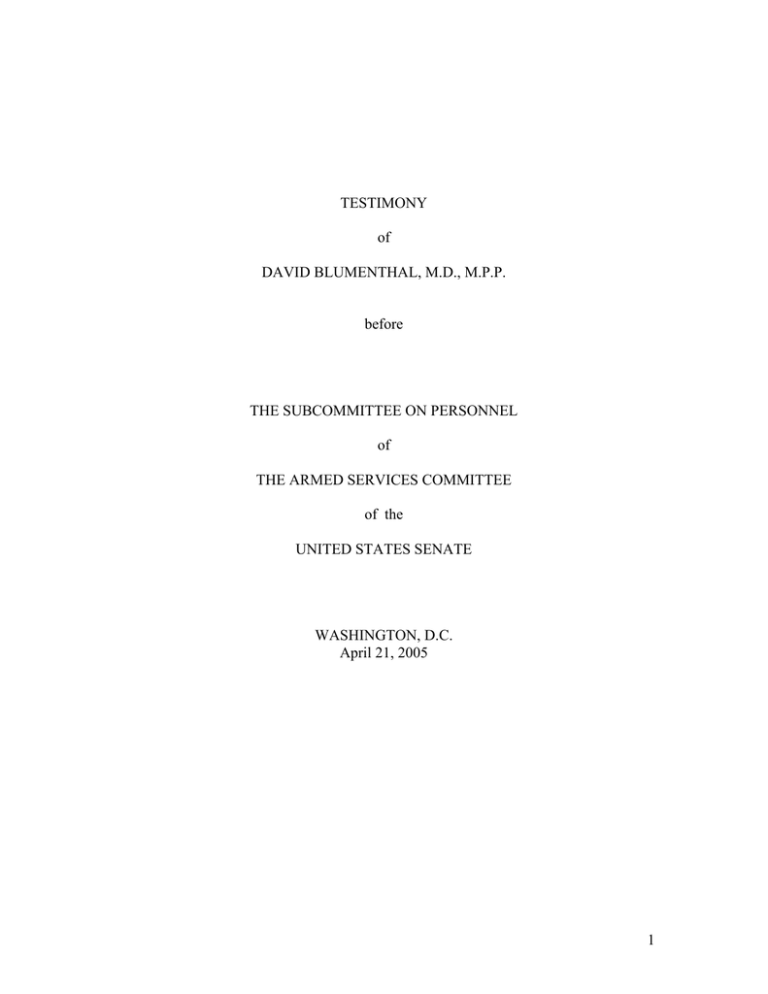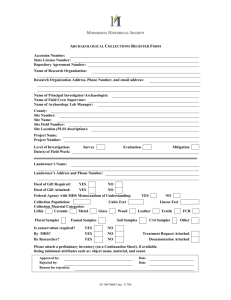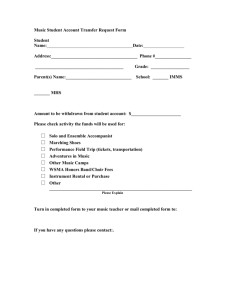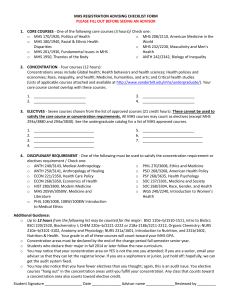TESTIMONY of DAVID BLUMENTHAL, M.D., M.P.P.
advertisement

TESTIMONY of DAVID BLUMENTHAL, M.D., M.P.P. before THE SUBCOMMITTEE ON PERSONNEL of THE ARMED SERVICES COMMITTEE of the UNITED STATES SENATE WASHINGTON, D.C. April 21, 2005 1 Mr. Chairman, members of the Subcommittee on Personnel, it is a pleasure and a privilege to appear before you today to discuss the current status of the Military Health System (MHS) of the United States Armed Forces. My name is David Blumenthal. I am a practicing general internist in Boston, Massachusetts, as well as Professor of Medicine and Health Care Policy at Harvard Medical School and Director of the Institute for Health Policy at Massachusetts General Hospital and the Partners Health System, also in Boston. I also direct the Harvard University Interfaculty Program for Health System Improvement. Like all Americans, I recognize the critical importance of the MHS to maintaining a strong national defense. Nothing is more vital to the readiness of our armed forces than caring promptly and well for the illnesses and injuries sustained by the men and women who volunteer to serve. Furthermore, given the uncertainties associated with obtaining health insurance in our civilian sector, the assurance of retiree health coverage provides an increasingly important tool for recruiting qualified individuals to our volunteer military. Therefore, the interest of this Subcommittee in the health of our MHS should be welcomed by all Americans. Before proceeding, I want to make clear to the Subcommittee that I am not an expert on the Military Health System, and for that reason, I do not intend to comment directly on its accomplishments and challenges. Rather, what I propose to do is highlight some on-going trends in the U.S. health system generally that may be relevant to thinking about the MHS. From my limited understanding, developments in the civilian health system of the U.S. are becoming more important to the MHS since an increasing number of beneficiaries of the MHS are receiving care outside military facilities. This is 2 particularly true, I believe, for one very important group: military retirees over 65 who are eligible for the Medicare program, and are now able to enroll in Tricare for Life, (TFL). The involvement of the MHS in caring for Medicare-eligible Americans means that the Department of Defense is getting to know up-close and personally some of the most difficult problems facing the Medicare program and the American health care system generally: how to get value for expenditures on the care of an aging population that is living longer with chronic illness in an age of exploding medical knowledge and technology. This is a challenge facing not only the MHS and the U.S. health care system, but every industrialized country around the world, and it is the challenge on which I would like to focus my remarks today. To eliminate any possible suspense, let me go right to the bottom line. There are no silver bullets, no shining examples of success, for dealing with the increasing costs associated with the care of Americans generally and older Americans in particular. The MHS has entered territory where, to use military analogies, the fight will be waged foxhole by foxhole over the long term. Don’t expect any brilliant maneuvers, any Inchon-style landings, to sweep away the problem of increasing health care costs for the elderly. Rather, to get the best value for the dollar in its new commitment to older military retirees, the Department of Defense will be forced to experiment, innovate, try and often fail – unless it chooses to give up territory by reducing its involvement in the care of this demanding population group. Costs of Care for Older Americans. Though I will not dwell on the benefits of care for older Americans in the U.S. today, I would like to balance my subsequent remarks by noting the enormous progress 3 that our health care system and its health care professionals have made in improving the health and health care of Americans generally and older Americans in particular. Indeed, the availability of those benefits – seen in increased life expectancy for the over 65, reduced rates of disability for that population, increased survival from particular illnesses like cardiovascular disease and stroke – is what makes the cost challenge so difficult. If the benefits were not so clear and palpable, it would be easier simply to reduce our investments in health care for this population. Furthermore, if those benefits did not exist, it would be less distressing to note another problem that plagues our civilian health care system: its failure, despite all that we spend, to provide beneficial services to many older Americans who need them. The costs of care within the Medicare program have increased steadily since the program’s inception in 1965. In the first three years of this decade, growth rates in spending ranged from 6 to almost 11 percent annually. Several salient observations about the costs of care for older Americans within our civilian health care sector should be kept in mind as the Executive Branch and the Congress consider approaches to containing costs within TFL. First, the costs of care in the United States generally, and for older Americans in particular, reflect overwhelmingly the costs of caring for chronic illnesses, such as high blood pressure, heart disease and cancer. I would expect that TFL’s costs will reflect this same phenomenon. The care of individuals with chronic conditions accounts for 78 percent of health expenditures in the United States. Individuals with more than one chronic condition account for a hugely disproportionate share of national health care spending. Patients with more than 5 chronic conditions have annual average health care 4 bills that are 15 times that of individuals with no chronic conditions. Those with more than one chronic condition account for 96 percent of Medicare spending; those with more than 5 account for two thirds. Thus, there is no way to find a solution to the cost problems of TFL without improving the way we care for the chronically ill elderly military retiree. Second, when we drill down to find out why costs are increasing for Americans – and especially those with chronic illnesses – we find that about 50 percent of the annual increase in costs can be attributable to doing more and different things for patients. The remaining 50 percent result from inflation generally, from incremental inflation in the medical sector (so called medical inflation), and from the aging of the population. What does doing more and different things mean? Let me give you some concrete examples from the care of patients with cardiovascular disease. One example is the use of angioplasty and the placement of stents in the coronary arteries of patients who have narrowing of those arteries. We now routinely perform this procedure for patients in the midst of heart attacks. Twenty years ago, there were no stents. Only recently has it become clear that using them in the midst of a heart attack saves lives. The procedure is extremely expensive, but it produces clear benefits. Another example is screening for so-called abdominal aortic aneurysms, which are weaknesses in the walls of one of the main arteries that carries blood pumped from the heart to other organs of the body. Such aneurysms can burst suddenly, and the result is massive internal hemorrhage and almost certain death. It is now clear that by screening older patients for these aneurysms and operating on them when we find them, we can prevent their rupture and save lives. We didn’t know this 10 years ago. The cost is very large. 5 A third example of doing more and different things is screening older Americans for cancer of the colon using colonoscopies. Twenty years ago, colonoscopies were done only when patients displayed symptoms of possible illness. Now they are done every ten years for everyone over 50, and more frequently if people have a family or personal history of colon cancer or polyps. I could give you many other examples of changes in health care practice that have contributed to the growing costs of caring for older Americans, especially those with chronic illness. The point is that care costs more in part because, as economists would say, the product we are buying has changed: it is a more complex and in certain ways higher quality product than it was ten or twenty years ago. A third general point to keep in mind about trends in health care for older Americans is that it needs improvement, and that this is likely to be the case for the care purchased on behalf of TFL beneficiaries as well. There are at least two ways in the health of older Americans falls short. The first way is that it is wasteful. Despite all the positive things I have noted about health care of our elderly, it is quite clear that it could be delivered at lower cost. This is most apparent in the huge variations in health care expenses per capita in different geographic regions of the United States. Medicare spends more than twice as much each year to take care of older Americans in Miami or Baton Rouge than it does in Eugene, Oregon or Minneapolis. There is absolutely no evidence that these differences in spending make the elderly in Baton Rouge healthier than in Minneapolis – indeed, there is some evidence to the contrary. The best predictor of Medicare spending per capita 6 seems to be not the intrinsic health needs of patients but the number of doctors and hospitals in the community. The second way in which the health care of older Americans could be improved is by making sure that they get the best care we know how to provide. Many studies demonstrate that the quality of health care provided older Americans is deficient. Heart attack victims often don’t get the drugs they should; diabetics don’t get their blood sugar tested or their eyes examined regularly; patients with asthma, depression or heart failure don’t get indicated medications. This, then, is the new terrain in which the MHS must wage its campaign to care for TFL beneficiaries: a health care system that is dominated by the needs of the chronically ill, that is doing more and better things for them than ever, but at the same time, is in many ways wasteful and plagued by quality deficiencies. The question that TFL must address, like many other stakeholders, is how to care for this demanding population in a way that preserves the best aspects of our private health care system while improving on its problems. Improving Health Care for Older Americans As I have already indicated, we do not have a stockpile of proven weapons for accomplishing this demanding set of objectives. What we have is some interesting ideas and some on-going experiments. Some of these ideas are powerful; some of the experiments are promising. The MHS also seems well positioned to take advantage of some of these ideas and experiments. The first idea – already well on its way to widespread testing – is greater reliance on information technology to improve quality and reduce costs of care for all patients, 7 including the older chronically ill. Health information technology (HIT) is a health care priority for the current administration because of its promise to improve the coordination and integration of health care, and thereby, to prevent waste and improve quality of services. The evidence supporting the benefits of HIT is far from complete or conclusive, but the technology has a compelling logic that makes the current emphasis justified. The MHS already has a robust HIT system for the facilities it operates, and this gives it an advantage in providing care within those facilities to TFL patients. This is one of several reasons that directing TFL beneficiaries to MHS owned and operated health care settings makes a good deal of sense. A second idea is to mobilize resources effectively in the care of chronically ill patients through several promising strategies. One is the use of so-called disease management techniques. These involve a variety of tools: reminders to patients, reminders to doctors, the creation of community-based support systems for involving families in the care of chronically ill patient, greater reliance on home care, and the use of information technology. The goal is to weave them into a coordinated plan of attack for making certain the chronically ill patients get the right care at the right time, nothing more, and nothing less. The Medicare program has embarked on an unprecedented national experiment to test the value of disease management programs. TFL should watch that experiment closely and be prepared to learn from its lessons. Indeed, the TFL may want to launch its own experiments tailored to its own special circumstances. Still a third idea is the pay for performance strategy, which my colleague on this panel, Dr. Robert Galvin, will discuss in detail. This is another approach that is both untested and compelling in its intuitive appeal. Medicare is also experimenting 8 extensively with this approach, and it would be worthwhile for the MHS to develop similar efforts that are adapted to its own circumstances. In this regard, another experiment that TFL should watch closely is under way in the United Kingdom. In its new contract with the nation’s general practitioners, the British National Health Service has promised to increase payments to GPs by up to 30 percent if they meet specified quality goals. The effects of this program on the costs as well as the quality of care will be extremely interesting to watch. A fourth idea, related to the third, is public reporting of quality and cost performance by health care providers. The limited evidence concerning quality reporting suggests that it stimulates some health care organizations and providers to examine their own quality and efficiency, and that the result may be improved performance in certain respects. A fifth idea is to try, as the MHS is already, to care for as many patients as possible within its own health care facilities. There are a number of reasons for doing this. One reason is the example of the Veterans Health Administration which is increasingly demonstrating that a large, centralized, public health care system can deliver services to chronically ill patients in ways that are higher in quality and at least as efficient as the fee for service system. The MHS may be able to replicate the success of the VHA in caring for older patients. Another example of the potential advantages of organized systems of care in managing the problems of older, chronically ill Americans is the Kaiser Permanente System, which has pioneered in a number of reforms to improve the efficiency and quality of care, including HIT and disease management. 9 These initiatives, approaches and programs offer some hope that TFL and other stakeholders in the U.S. health care system can manage the central health care problem of our time: providing the older chronically ill the benefits of modern health care services in an affordable way. Achieving victory in this struggle will require as much ingenuity and perseverance, and perhaps more, than any other mission facing the armed forces of the United States. But it is well worth the effort. Thank you for your attention. I would be pleased to answer any questions you may have. 10






